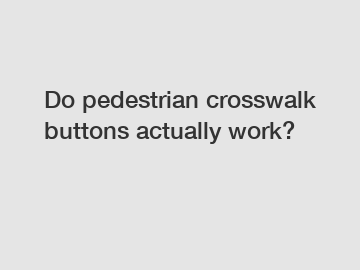Do pedestrian crosswalk buttons actually work?
Do pedestrian crosswalk buttons actually work?
Pedestrian crosswalk buttons are a common sight in cities around the world. They are designed to allow pedestrians to request a crossing by simply pressing a button. However, there has been some debate about whether these buttons actually work or if they are just a placebo.
The purpose of these buttons is to provide pedestrians with a sense of control over their own safety. They are meant to give pedestrians the feeling that they have some influence over the traffic signal and can request a safe crossing. This is especially important for people with disabilities or mobility issues, who may need extra time to cross the street.

There are two main types of pedestrian crosswalk buttons: actuated and non-actuated buttons. Actuated buttons are ones that are connected to the signal system and actually change the timing of the traffic light. When a person presses the button, it triggers a signal to the traffic control system, which adjusts the timing to provide a pedestrian crossing. Non-actuated buttons, on the other hand, are simply placebo buttons that don't have any effect on the traffic signal.
So, do these buttons actually work? The answer is, it depends. In some cases, especially in areas with heavy pedestrian traffic, actuated buttons are indeed connected to the traffic control system and can change the timing. This means that when a pedestrian presses the button, they are actually influencing when the traffic light will change, giving them more time to cross safely.
However, in many situations, especially in lower pedestrian traffic areas or during off-peak times, the buttons may not actually be connected to the signal system. In these cases, the buttons are simply there to give pedestrians the illusion of control. Pressing the button may have no effect on the traffic light timing, but it can still provide a sense of comfort and reassurance to pedestrians.
It's important to note that the absence of an actuated button doesn't necessarily mean that the signal timing is not pedestrian-friendly. Many traffic signals are programmed to provide regular pedestrian intervals regardless of whether the button is pressed or not. These signals are designed to offer adequate time for pedestrians to cross safely without the need for button activation.
In recent years, there has been a move towards what is known as "beg buttons" which require pedestrians to push a button to request a crossing even when there is already a green light for vehicles. This practice has raised concerns among pedestrian advocates, as it places the burden on pedestrians to activate a crossing and may lead to longer wait times.
In conclusion, pedestrian crosswalk buttons can indeed work in some cases, particularly in areas with heavy pedestrian traffic. However, in many situations, they may serve more as a psychological tool rather than a functional one. Regardless of their effectiveness, it's important for pedestrians to always exercise caution and follow traffic laws when crossing the street.
If you have any further questions or concerns about pedestrian crosswalk buttons, please feel free to contact us. Your feedback is valuable to us as we continue to improve pedestrian safety measures in our community.
Want more information on Mobile Traffic Light, variable message signs price, VMS Control Software? Feel free to contact us.

Comments